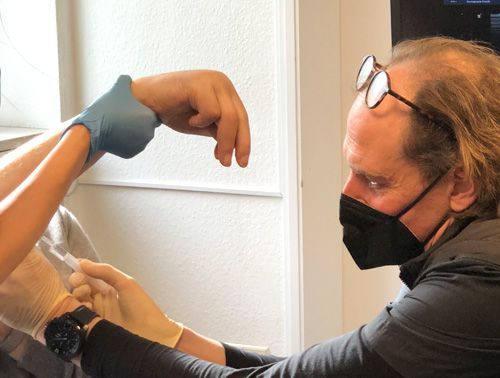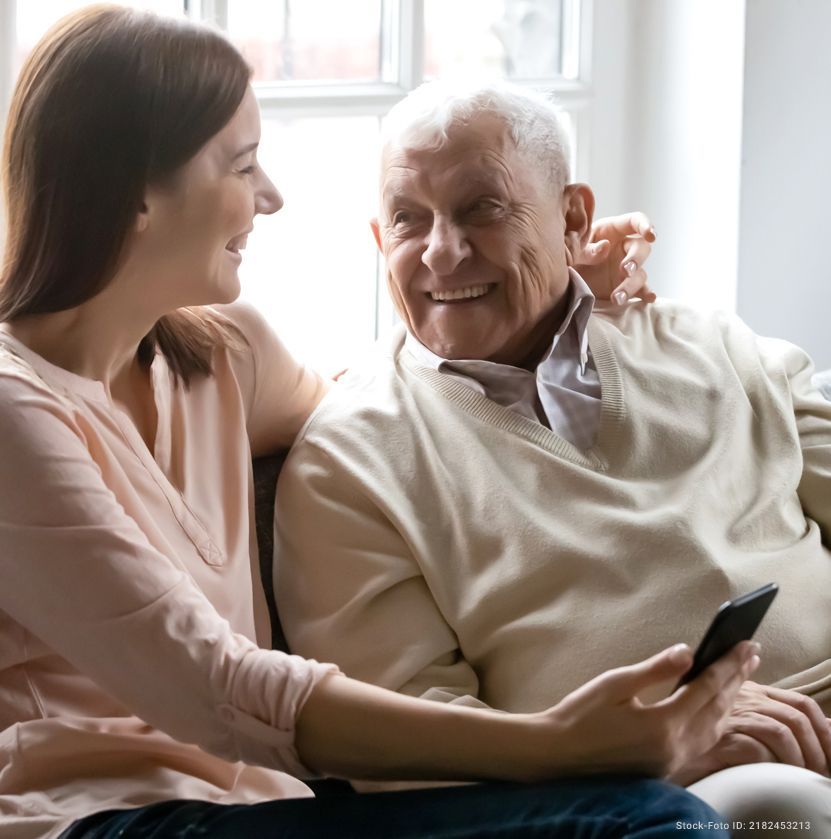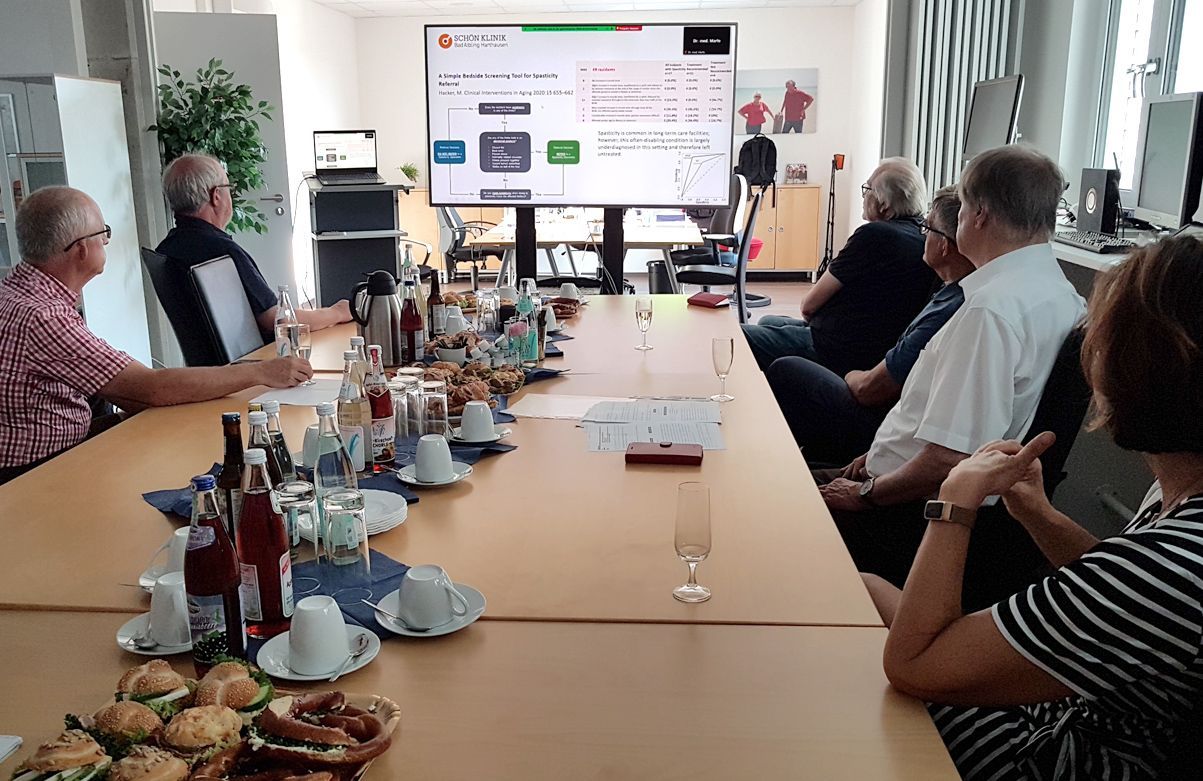Current
16.05.2024
Workshop on the concept of guided self-rehabilitation
Workshop on the concept of guided self-rehabilitationTowards integrated spasticity management: The spasticity app and the guide to self-rehabilitationThursday, May 16, 2024
- 5:00 p.m. – Welcome5:15 p.m. – Multi-professional spasticity management, Dr. Müller5:30 p.m. – The spasticity app and the MOVE-IT project, Dr. Müller6:00 p.m. – The concept of guided self-rehab: stretching positions, movement exercises and documentation, Steinböck6:30 p.m. – Demonstration on patients, Dr. Müller/Steinböck6:45 p.m. – End
Speakers: Dr. Dipl. Psychologist Friedemann Müller, Chief Physician, Schön Klinik Bad Aibling Harthausen Martina Steinböck, M.Sc, Physiotherapist, Schön Klinik Bad Aibling Harthausen Patients with severe paralysis after a stroke develop a disability due to spasticity in at least 20 percent of cases, which is usually only inadequately treated. Due to the complexity of the syndrome, the term spasticity is increasingly being replaced by the term "spastic movement disorder" (SBS). A multi-professional approach is essential for successful treatment. However, the possibilities and activities of affected patients themselves are increasingly coming into focus. Increasing the intensity of therapy is a goal in almost all rehabilitation efforts. Self-exercises are particularly effective when used by SBS patients in combination with BoNT therapies. The concept of guided self-rehabilitation goes back to the French neurologist Jean-Michel Gracies: It recommends that patients undertake a daily self-training program for the muscles of the spastic limbs and is monitored using a diary-based strategy. The techniques include static stretching postures alternating with rapid alternating movements, each with maximum amplitude, in order to gradually reduce the co-contraction of the antagonists. The Engage study showed that the therapeutic effect could be maintained after administration of BonNT and further improved by additional injection treatments.15 (Gracies et al. 2021).We want to make this therapy option available to our patients as well and therefore introduce it in this workshop.Advanced training points at Blaek have been applied for.Venue:Schön Klinik Bad Aibling HarthausenRaum Starnberger SeeKolbermoorer Straße 7283043 Bad Aiblingwww.schoen-klinik.de/bad-aibling-harthausen
06.05.2024 Discover the latest trends and innovations in the field of telemedicine: Our projects are presented in the online magazine!
09.02.2024 Article from our cooperation partner - Stroke SupportRisk factors: Periodontitis as a risk factor for stroke
Guest article by a dentist about what periodontitis has to do with strokes. There are numerous risk factors for the development of cardiovascular diseases, including stroke. Periodontitis is one such risk factor - vascular and heart diseases are closely related to periodontal diseases. If untreated, severe periodontitis occurs, changes in the arteries can be found that increase the risk of coronary heart disease, heart attack and stroke. ...Link to articlehttps://schlaganfallbegleitung.de/risikofaktoren/parodontitis?utm_source=sab&utm_medium=newsletter&utm_campaign=2024-02
23.10.2023 Article in the Ärzteblatt ThüringenGuideline-based treatment of stroke-associated spasticity: Botulinum toxin used too rarely
According to expert estimates, around 10,000 people in Thuringia suffer a stroke every year. Of the stroke survivors, around 30 to 40 percent subsequently develop a spastic movement disorder within around six months. This not only leads to clinically relevant functional limitations, but also sometimes causes considerable pain and difficulties in terms of care and personal hygiene. The quality of life of those affected is usually significantly reduced. ...Link to articlehttps://www.aerzteblatt-thueringen.de/pdf/thu2310_033.pdf
26.09.2023 Press ReleaseThe Spasticity App for Your Health – Life after a Stroke
Baar-Ebenhausen, September 26, 2023 - The innovative spasticity app, developed by Prof. Dr. med. Siegfried Jedamzik with the support of Dr. med. Dipl.-Psych. Friedemann Müller, Chief Physician of Neurological Early Rehabilitation & Rehabilitation at Schön Klinik Bad Aibling Harthausen, now offers an innovative solution for patients and their families who are faced with the aftermath of a stroke. An impressive example of the benefits of the spasticity app is the story of Ms. M. Huber, whose grandfather recently suffered a stroke. "It was a scary and uncertain time for our family," she says. "But with the discovery of the spasticity app, we felt better equipped to deal with the challenges that a stroke brings."Read more - download pdf
Opening of 3 BoNT centers in Ingolstadt and Region 10!

Impressions of the hybrid training on 11.07.2023
11.07.2023
Invitation to a free hybrid training course (online and on-site) in the Ingolstadt area "Improving care management and quality of care after a stroke with regard to spasticity" Date: Tuesday, July 11, 2023 Time: 6:30 p.m. to 8:00 p.m. Location: Bayerische TelemedAllianz (BTA), Brückenstr. 13 a, 85107 Baar-Ebenhausen near Ingolstadt Training points: 2
Be there when the GOIN medical network holds a training event for you. Seize the opportunity and get up-to-date information from the first source. We look forward to welcoming you on site or online to this training event. You can also log in with your mobile phone if you download the Zoom app and scan the QR code.Your speakers / topics:Prof. Dr. med. Siegfried Jedamzik, general practitioner and 1st Chairman GO IN eV"Analog and digital control poststroke with e-prescription and electronic patient file in the telematics infrastructure" from 6:30 p.m. to 7:15 p.m.Dr. Friedemann Müller, Chief Physician Schön Klinik Bad Aibling SE & Co KG"Motivation for secondary prevention after stroke" from 7:15 p.m. to 8:00 p.m.
26.05.2023
Order flyers now!!! 📑 📚Free flyers for the spasticity app for patients after a strokeHere you can order flyers that are in stock for your patients for your practice, clinic or facility free of charge. Send us an email to hess@telemedallianz.de
23.03.2023
Visit to Dr. Schramm (neurologist) at the NeuroPraxis in Fürth

Photos: Practice Dr. med. Axel Schramm

On Thursday, March 23, 2023, Prof. Dr. med. Siegfried Jedamzik and Ms. Hess had the opportunity to look over Dr. med. Axel Schramm's shoulder at work in the NeuroPraxis in Fürth. Dr. med. Axel Schramm is an experienced neurologist who specializes in the treatment with botulinum toxin (BoNT).During the visit, Dr. med. Axel Schramm showed the two visitors how he treated three patients with BoNT. The first patient had congenital spasticity and was treated with BoNT on his hand and foot. The second patient had cervical dystonia and was treated with BoNT in several places on his neck and throat. The third patient had spasticity in his right arm after a stroke and was treated with BoNT in several places.Due to the different diagnoses, Prof. Dr. med. Siegfried Jedamzik and Ms. Hess were able to see Dr. med. Axel Schramm can understand this very well. A medical assistant supported him by helping the patient get dressed and undressed, drawing up the medication and assisting with the BoNT therapy. Dr. med. Axel Schramm used the support of ultrasound to place the medication precisely at the correct spot in the muscles. As a neurologist, Dr. med. Axel Schramm has special training to recognize muscles, nerves, vessels and organs in the ultrasound image and thus ensure a precise injection.Prof. Dr. med. Siegfried Jedamzik had the opportunity to interview the patients and all patients stated that they felt a significant relief of their symptoms, even pain relief, after just a few days of treatment. These successes are the result of Dr. med. Axel Schramm's outstanding work and his expertise in this field.The visit to Dr. med. Axel Schramm in his practice in Fürth was a valuable experience for Prof. Dr. med. Siegfried Jedamzik and Ms. Hess. They were impressed by the professionalism and expertise of Dr. Axel Schramm and the great results he achieved with his BoNT therapy. They wish him continued success and are grateful for the opportunity to observe his work up close.
09.03.2023
Invitation to a short online meeting with Prof. Dr. med. Siegfried Jedamzik
Topic: What is a BoNT center?How does my practice/clinic become a BoNT center?Speaker:Prof. Dr. med. Siegfried Jedamzik
General practitioner and professor of computer science
Date: 09.03.2023 from 7 p.m. to 7:15 p.m. 💻 Access link digital participation
Join Zoom Meetinghttps://us06web.zoom.us/j/85067732820?pwd=bTJFWjNiZzdTTlFyb3dXWWxVYUowQT09We look forward to your participation!Previous registration is not required. When you dial in, you can add a pseudonym to your name and of course turn off the camera. The BTA and GOIN eV doctors' network team will be happy to provide you with technical support. Contact: 08453-33499-14 or email hess@telemedallianz.de.
02/28/2023ÄRZTEBLATT MECKLENBURG - VORPOMMERNIssue 10/2022, p. 393 - 396 | Author: Buchmann, Johannes, Prof. Dr. med. habil.
Survey results on the care of patients with spastic movement disorder (SMD) after a stroke or with ICPIn 2020, the authors of this article commented on the care of patients with SMD (spastic movement disorder) in Mecklenburg-Western Pomerania at the request of the then Ministry of Economic Affairs, Labor and Health MV. This statement was published in issue 3/2020 of the Ärzteblatt MV.
Link to article:
https://www.aerzteblatt-mvp.de/pdf/mv2210_393.pdf
15.02.2023Article on schlaganfallbegleitung.deTherapy - Botulinum toxin for the treatment of spasticity in stroke therapy
- What are spastic movement disorders?What treatment is available for spastic movement disorders?What is botulinum toxin A?Why botulinum toxin A?How do I recognize a spastic movement disorder?What are the benefits of early treatment?
Link to article:
https://schlaganfallbegleitung.de/behandlung/botox-schlaganfall-therapie
01/31/2023Patients before and after treatment with botulinum toxinImprovement of gait stability and reduction of the risk of falls through botulinum toxin type A in spastic-dystonic supinated-inverted equinus after a stroke.




















